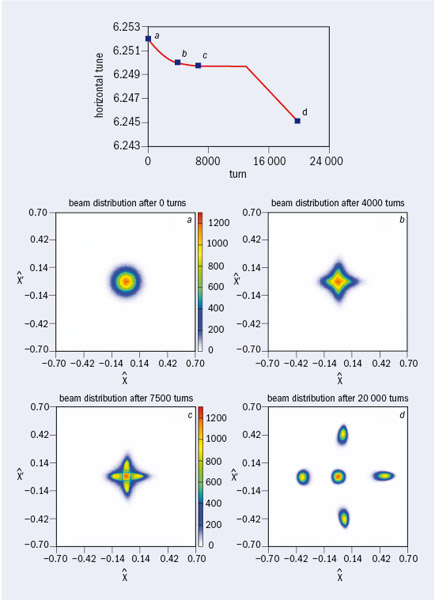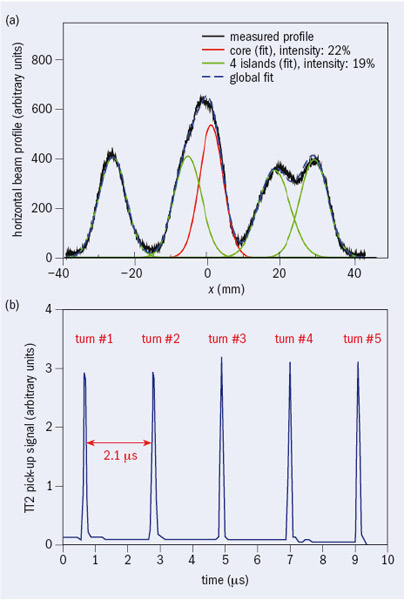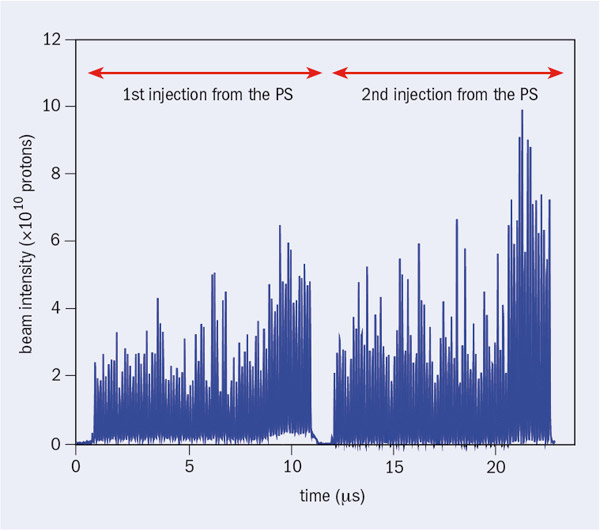A more efficient technique is put through its paces.
In 2001 a team at CERN proposed a new scheme for ejecting beam from a circular particle accelerator over a few turns using magnets that generate nonlinear fields. The aim was to replace the so-called continuous transfer (CT) technique, which is used to transfer protons between the PS and the SPS for fixed-target physics and the CERN Neutrinos to Gran Sasso (CNGS) project.

CT dates from the 1970s and is based on slicing beam onto an electrostatic septum that is used to split off some of the orbiting beam. In the scheme, the horizontal tune (the number of betatron oscillations per turn, QH) is set to 6.25 so that the beam rotates by 90° in phase space every turn. A system of slow- and fast-pulsing dipoles (acting on a few milliseconds and microseconds, respectively) is used to displace the proton beam horizontally across the septum so that at each turn approximately one-fifth of the beam is sliced off by the septum blade (figure 1). This slice is then deflected by the field of the septum so that it enters into a second septum downstream – the magnetic extraction septum. The whole beam is extracted in five turns.
The choice of a five-turn extraction is dictated by the use of two PS cycles to fill the SPS ring, which has a circumference that is 11 times as large as that of the PS. By ejecting the beam over five turns at the end of two consecutive PS cycles, ten-elevenths of the SPS circumference is filled. One-eleventh of the circumference remains empty to avoid interference between the circulating beam and the transient times of the SPS injection kickers.
Making beamlets
In the new scheme, which has been named multiturn extraction (MTE), the beam is split horizontally into five beamlets – one in the centre and four in stable islands of the horizontal phase space. These islands are generated by nonlinear fields of sextupole and octupole magnets and are separated by sweeping the horizontal tune through the stable one-fourth resonance, QH = 6.25 (figure 2). The beamlets circulate in the PS until they are moved, turn by turn, beyond the magnetic extraction septum by dedicated slow and fast closed bumps. The separation of the beamlets that is necessary to avoid intercepting the extraction septum is controlled by the value of the horizontal tune at the end of the resonance crossing, as well as by the strength of the nonlinear magnets. This method no longer requires the electrostatic septum.

This approach has several advantages compared with the original CT extraction. First, there is no interaction between the beam and the septum blade, the losses of which limit high-intensity operations. Second, the beamlets trapped in the islands can have the same intensity, emittance and optical parameters at extraction. This eases the matching with the receiving accelerator, which would not be possible with CT. Third, several parameters, such as the strengths of the nonlinear magnets, the speed at which the resonance is crossed and the final horizontal tune, are available to adjust and optimize the parameters and separation of the beamlets simultaneously. In CT, only the fast-bump amplitude can be used to equalize the intensities or emittances of the beamlets. Moreover the MTE scheme can be time reversed, which could allow a multiturn injection (MTI) based on stable islands.
MTE in practice
To complement the theoretical analysis, extensive measurement campaigns began at the PS in 2002 to assess the feasibility of loss-free beam-splitting by crossing the stable one-fourth resonance. This was essential before undertaking any hardware upgrade of the PS machine, such as new octupole magnets and fast dipoles for a dedicated orbit bump. In 2004 the tests achieved the necessary loss-free beam-splitting even with a high-intensity, single-bunch beam of about 6 × 1012 protons. The next step was to ensure that an equal intensity was shared between the four beamlets trapped in the islands and the beam core. To avoid unwanted transient effects in the SPS, the scheme has to give a maximum difference of about 5% in the relative intensities of the islands and the core. In tests, the best beam-sharing that we achieved was about 18% in each of the four islands and about 28% in the central core. This intensity ratio is slightly out of specification but should be compared with the accuracy of the determination of the beamlets’ profiles and hence their intensity, which is a few per cent.

The positive outcome of the experimental tests led to the approval of the PS MTE project. This should provide a considerable reduction of beam losses in the PS, which is particularly crucial for the production of high-intensity proton beams for CNGS. The project, started in 2006, should last until 2010 with the peak effort for hardware production and installation occurring during the winter shutdown of 2007/2008 and first beam commissioning by mid-2008.
Implementing MTE has involved a considerable number of hardware modifications in the PS ring. The slow bump that is used to displace the split beam towards the magnetic extraction septum is generated by six magnets, each with independent power converters. This is necessary to shape the bump to optimize the available mechanical aperture. (Originally the extraction bump was generated by only four magnets that shared a common power supply.) The fast bump that is used to move the split beam across the extraction septum is generated by three fast dipoles (kickers) with three new pulse-forming networks (PFNs). In addition, new octupole magnets have been designed and built – two straight sections have each been equipped with two sextupoles and one octupole to generate and manipulate the stable islands used for beam trapping. Globally, a review of the mechanical aperture, in the light of higher requirements imposed by the split beam, implied the need for a larger vacuum chamber in the extraction region, including the complex y-shaped chamber at the extraction point. A second phase will be implemented during the winter shutdown of 2009/2010. This will aim to improve the performance of the kickers in the ring and in the transfer line, the latter being used to correct the trajectory variations among the extracted turns.
Extraction testing
In May and June 2008 beam splitting was resumed using the newly installed sextupoles and octupoles, again achieving a loss-free process with a single bunch of about 3 × 1012 protons. At the same time the new slow bump was commissioned so that it was ready for the extraction tests in July 2008 when the PFNs, completed and hardware-commissioned, became available for the beam tests. Then, on 1 August, five beamlets with almost the same intensity were successfully created from a single bunch of 3 × 1012 protons and extracted in the first part of the transfer line, TT2, to the SPS. Figure 3a shows the measured horizontal beam profile in the PS at the end of the splitting process, with a fit of the five beamlets superimposed. Figure 3b shows the intensity signal of a pick-up in the TT2 transfer line. Each of the five peaks corresponds to a beamlet extracted over a single turn, whereas the distance between them corresponds to the PS revolution time of 2.1 μs.

The rest of the commissioning period until the end of the SPS-physics run on 3 November 2008 was dedicated to studying the best longitudinal structure for beam delivery and injection into the SPS, and it included a campaign of measurements of the optical parameters in the transfer line between the PS and the SPS machines. In the end it was possible to extract from the PS a beam bunched on harmonic number h = 16, corresponding to 16 × 5 beamlets, for a total intensity of about 0.7 × 1013 protons. This beam was injected into the SPS, accelerated and then extracted onto the CNGS target to produce the first neutrinos from an MTE beam.
Figure 4 shows the signal from the fast beam-current transformer in the SPS after the injection of the second PS cycle. The two batches separated by the gaps required by the finite rise time of the SPS injection kickers are clearly visible, as well as the bunched structure. During the last part of the PS run, when the SPS was already shut down, it was possible to set up a new completely debunched MTE beam – that is, with the longitudinal structure that provides the best SPS performance – with a total intensity of about 1.3 × 1013 protons. This yielded typical extraction efficiencies of 97–98%, with peaks of 99%. This is the maximum theoretical efficiency, given the unavoidable losses owing to the finite rise time of the PS extraction kickers. The corresponding extraction efficiency for a CT beam with the same intensity is 95%. In addition, the losses for MTE are localized around the extraction magnetic septum, while in the case of the CT, the losses are distributed through a wider part of the machine circumference, affecting a larger number of active elements.
For the 2009 start-up the plan is to begin by delivering CT beams to the SPS, but to resume MTE operation with a view to replacing the low-intensity CT extraction for fixed-target physics by mid-2009. Soon after, the beam for CNGS will also be generated with MTE, with the intensity gradually increased towards the nominal value.







